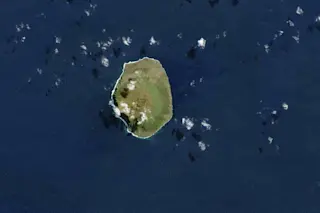Amsterdam: The Lonely Island. Seen on April 11, 2015. Landsat 8/OLI NASA/USGS We talk a lot about volcanoes that are near population centers---and rightly so. They can produce deadly eruptions that have local and global consequences. That got me thinking ... what about on the other end? What is the most remote active volcano on the planet, farthest from people or even farther from any other land mass that people might live. Now, I'm not sure if this is categorically the most remote volcano, but I'm pretty sure it has to be close. I present you Amsterdam Island in the southern Indian Ocean! Amsterdam Island is staggeringly far from anything:
4,300 kilometers (2,670 miles) from Africa
3,400 kilometers (2,100 miles) from Madagascar
5,000 kilometers (3,100 miles) from Sri Lanka
3,450 kilometers (2,140 miles) from Australia
3,200 kilometers (1,990 miles) from Antarctica
Heck, the closest populated area I could find was ...














